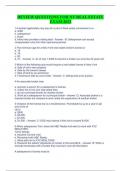Samenvatting
Institutional Perspectives: Summary of the Literature
In the summary, the following articles are included: 1. Rhodes (2012) Waves of Governance 2. Stoker (2019) Governance as theory: five propositions 3. Steurer (2013) Distangling governance: a synoptic view of regulation by government, business and civil society. 4. Alexander (2002) The public in...
[Meer zien]













